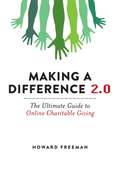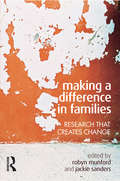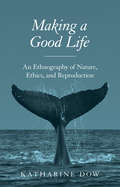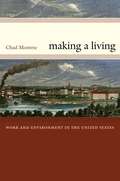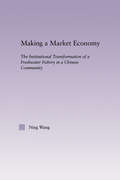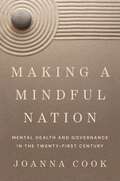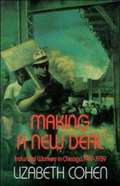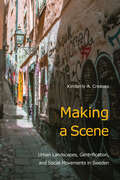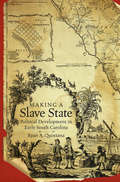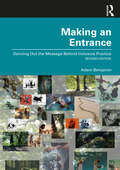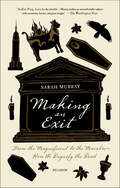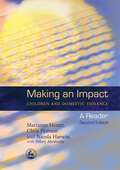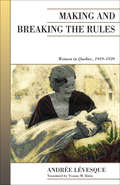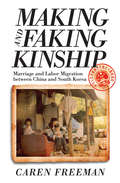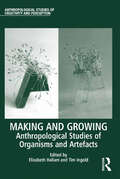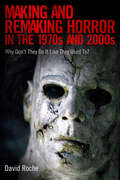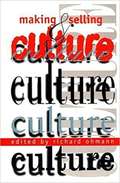- Table View
- List View
Making Work, Making Trouble
by Deborah BrockThoroughly updated to include events that have occurred in the decade since it was originally published, this second edition of Making Work, Making Trouble re-establishes this work as the pre-eminent study of prostitution in Canada. Detailing the various forces that have presented prostitution as a social problem, Deborah R. Brock examines anti-prostitution campaigns, urban development, new policing strategies, and the responses of the media, the courts, and governments, as well as feminist, rights, and residents' organizations.Paying particular attention to rights and the means of economic survival within global and local realities, this edition includes new material on recent discourse on sex trafficking, migrant sex work, ex-worker rights organizing, and considers the potential impact of the Robert Pickton trial on the practice of sex work. A comprehensive overview of the crucial debates on prostitution, Making Work, Making Trouble is a welcome addition to twenty-first century sociology and criminology.
Making Your Case: Using R For Program Evaluation
by Charles Auerbach Wendy ZeitlinThis book specifically addresses using R to evaluate programs in organizational settings. The book is divided into three sections. The first section addresses background information that is helpful in conducting practice-based research. The second section of the book provides necessary background to begin working with R. Topics include how to download R and RStudio, navigation, R packages, basic R functions, and importing data. This section also introduces The Clinical Record, a freely available database program to help organizations record and track client information. The remainder of the book uses case studies to illustrate how to use R to conduct program evaluations. Techniques include data description and visualization, bivariate analysis, simple and multiple regression, and logistic regression. The final chapter illustrates a comprehensive summary of the skills demonstrated throughout the book using The Clinical Record as a data repository.
Making Yugoslavs
by Christian Axboe NielsenWhen Yugoslavia was created in 1918, the new state was a patchwork of Serbs, Croats, Slovenes, and other ethnic groups. It still was in January 1929, when King Aleksandar suspended the Yugoslav constitution and began an ambitious program to impose a new Yugoslav national identity on his subjects. By the time Aleksandar was killed by an assassin's bullet five years later, he not only had failed to create a unified Yugoslav nation but his dictatorship had also contributed to an increase in interethnic tensions.In Making Yugoslavs, Christian Axboe Nielsen uses extensive archival research to explain the failure of the dictatorship's program of forced nationalization. Focusing on how ordinary Yugoslavs responded to Aleksandar's nationalization project, the book illuminates an often-ignored era of Yugoslav history whose lessons remain relevant not just for the study of Balkan history but for many multiethnic societies today.
Making a Difference 2.0: The Ultimate Guide to Online Charitable Giving
by Howard FreemanThe digital age has changed the way people contribute to worthy causes, with more and more donations coming from online sources. Making a Difference 2.0 serves as a bible for tech-savvy contributors and an essential starting block for beginners, explaining the ins and outs of online charity, how it can differ from traditional methods of fundraising and donating, and how to ensure your contribution is being put to its best use. The book is targeted for two separate audiences- those that donate and those that utilize donations given to them. An exhaustive index is included listing and rating all online giving platforms.
Making a Difference in Families: Research that creates change
by Robyn Munford'This 'must read' volume will challenge every researcher to re-examine their assumptions and approach to research with families. Munford and Sanders emphasise the positive contribution research can make through the development of an inclusive research process. Their model extends the principles of the action research method by emphasising the contribution of families at each stage of the research, and dissemination of results through an easily assessable 'range of research products'. The thought-provoking case studies articulate the strengths and realities of applying their model in a wide variety of settings in different countries.' - Angeline Barretta-Herman, Professor of Social Work, University of St Thomas'This book tackles the hard issues which are becoming of vital importance for all researchers. How our research can make a difference to research participants and our communities, and also satisfy the needs of other players, are some of the difficult questions this book addresses. The book's direct approach, and its inclusion of work from around the globe, make it widely applicable.' - Professor Jan Fook, La Trobe UniversityDoing research with families poses particular challenges in social work and welfare. The families are generally clients of social services, and can be in a vulnerable position. Also, it is important that family research contributes to improving practice in clinical and community work.Making a Difference in Families discusses key approaches to research with families, including action research, focus groups and participant observation. Contributors explore both qualitative and quantitative methods, and examine ways in which researchers can involve participants in the research process. Detailed case studies are provided of research in a variety of settings, and with different kinds of family situations.
Making a Good Life: An Ethnography of Nature, Ethics, and Reproduction
by Katharine DowMaking a Good Life takes a timely look at the ideas and values that inform how people think about reproduction and assisted reproductive technologies. In an era of heightened scrutiny about parenting and reproduction, fears about environmental degradation, and the rise of the biotechnology industry, Katharine Dow delves into the reproductive ethics of those who do not have a personal stake in assisted reproductive technologies, but who are building lives inspired and influenced by environmentalism and concerns about the natural world's future.Moving away from experiences of infertility treatments tied to the clinic and laboratory, Dow instead explores reproduction and assisted reproductive technologies as topics of public concern and debate, and she examines how people living in a coastal village in rural Scotland make ethical decisions and judgments about these matters. In particular, Dow engages with people's ideas about nature and naturalness, and how these relate to views about parenting and building stable environments for future generations. Taking into account the ways daily responsibilities and commitments are balanced with moral values, Dow suggests there is still much to uncover about reproductive ethics. Analyzing how ideas about reproduction intersect with wider ethical struggles, Making a Good Life offers a new approach to researching, thinking, and writing about nature, ethics, and reproduction.
Making a Life: Young Men on Johannesburg’s Urban Margins
by Hannah J DawsonMaking a Life explores the dynamic everyday life-making strategies of young men in Zandspruit, a sprawling informal settlement on the outskirts of Johannesburg. In many ways Zandspruit typifies the precariousness of life within South Africa, where two-thirds of young people lack waged employment. However, rather than seeing Zandspruit as dumping ground, Hannah Dawson calls for an integrated understanding of the complex linkages between people’s lives and livelihoods, and the multifaceted socio-political landscape of urban settlements. Based on 14 months of ethnographic research, Dawson investigates how social belonging, identity and economic realities intertwine in places such as Zandspruit. This approach not only challenges conventional approaches to studying work; it also questions the increasingly prevalent perspective that romanticises the adaptive survival strategies of the urban poor. By exploring the intricate connections between those with and without wages, the author shows how young men manage complex social, political and economic conditions. Making a Life offers insights into issues such as urban work, citizenship, un(der)employment and inequality in South Africa. At the same time, it contributes to a global understanding of how young people – men especially – manage economic uncertainty.
Making a Living
by Chad MontrieIn an innovative fusion of labor and environmental history, Making a Living examines work as a central part of Americans' evolving relationship with nature, revealing the unexpected connections between the fight for workers' rights and the rise of the modern environmental movement.Chad Montrie offers six case studies: textile "mill girls" in antebellum New England, plantation slaves and newly freed sharecroppers in the Mississippi Delta, homesteading women in the Kansas and Nebraska grasslands, native-born coal miners in southern Appalachia, autoworkers in Detroit, and Mexican and Mexican American farm workers in southern California. Montrie shows how increasingly organized and mechanized production drove a wedge between workers and nature--and how workers fought back. Workers' resistance not only addressed wages and conditions, he argues, but also planted the seeds of environmental reform and environmental justice activism. Workers played a critical role in raising popular consciousness, pioneering strategies for enacting environmental regulatory policy, and initiating militant local protest.Filled with poignant and illuminating vignettes, Making a Living provides new insights into the intersection of the labor movement and environmentalism in America.
Making a Market Economy: The Institutionalizational Transformation of a Freshwater Fishery in a Chinese Community (East Asia: History, Politics, Sociology and Culture)
by Ning WangFirst published in 2005. Routledge is an imprint of Taylor & Francis, an informa company.
Making a Mindful Nation: Mental Health and Governance in the Twenty-First Century
by Joanna CookHow mindfulness came to be regarded as a psychological support, an ethical practice and a component of public policyMindfulness seems to be everywhere—in popular culture, in therapeutic practice, even in policy discussions. How did mindfulness, an awareness training practice with roots in Buddhism, come to be viewed as a solution to problems that range from depression and anxiety to criminal recidivism? If mindfulness is the answer, asks Joanna Cook, what is the question? In Making a Mindful Nation, Cook uses the lens of mindfulness to show how cultivating a relationship with the mind is now central to the ways people envision mental health. Drawing on long-term fieldwork with patients, therapists, members of Parliament and political advocates in Britain, Cook explores how the logics of preventive mental healthcare are incorporated into people’s relationships with themselves, therapeutic interventions, structures of governance and political campaigns.Cook observed mindfulness courses for people suffering from recurrent depression and anxiety, postgraduate courses for mindfulness-based therapists, parliamentarians’ mindfulness practice and political advocacy for mindfulness in public policy. She develops her theoretical argument through intimate and in-depth stories about people’s lives and their efforts to navigate the world—whether these involve struggles with mental health or contributions to evolving political agendas. In doing so, Cook offers important insights into the social processes by which mental health is lived, the normative values that inform it and the practices of self-cultivation by which it is addressed.
Making a New Deal
by Lizabeth CohenThis book examines how it was possible and what it meant for ordinary factory workers to become effective unionists and national political participants by the mid-1930s. We follow Chicago workers as they make choices about whether to attend ethnic benefit society meetings or to go to the movies, whether to shop in local neighborhood stores or patronize the new A & P. Although workers may not have been political in traditional terms during the '20s, as they made daily decisions like these, they declared their loyalty in ways that would ultimately have political significance. As the depression worsened in the 1930s, not only did workers find their pay and working hours cut or eliminated, but the survival strategies they had developed during the 1920s were undermined. Looking elsewhere for help, workers adopted new ideological perspectives and overcame longstanding divisions among themselves to mount new kinds of collective action. Chicago workers' experiences as citizens, ethnics and blacks, wage earners and consumers all converged to make them into New Deal Democrats and CIO unionists. First printed in 1990, Making a New Deal has become an established classic in American History. The second edition includes a new introductory essay by Lizabeth Cohen.
Making a New Deal: Industrial Workers in Chicago, 1919-1939
by Lizabeth CohenA richly detailed portrait of working-class life in the 1920s and 1930s.
Making a Scene: Urban Landscapes, Gentrification, and Social Movements in Sweden
by Kimberly A. CreasapIn the three largest cities in Sweden, social movement “scenes”—networks of social movement actors and the places they inhabit—challenge threats such as gentrification. The geography of the built environment influences their ability to lay claim to urban space and to local political processes. In Making a Scene, Kimberly Creasap emphasizes that it is the centrality, concentration, and visibility of these scenes that make them most effective. Whereas some scenes become embedded as part of everyday life—as in Malmö—in contrast, scenes in Göteborg and Stockholm often fail to become part of the fabric of urban neighborhoods. Creasap investigates key spaces for scenes, from abandoned industrial areas and punk clubs to street festivals, bookstores, and social centers, to show how activists create sites and develop structures of resistance that are anti-capitalist, anti-fascist, anti-gentrification, queer, and feminist. She also charts the relationship between scenes and city spaces to show these autonomous social movements create their own cultural landscapes. Making a Scene encourages critical thinking about spatiality and place in the sociology of social movements and the role of social movements as important actors in urban development.
Making a Slave State: Political Development in Early South Carolina
by Ryan A. QuintanaHow is the state produced? In what ways did enslaved African Americans shape modern governing practices? Ryan A. Quintana provocatively answers these questions by focusing on the everyday production of South Carolina's state space—its roads and canals, borders and boundaries, public buildings and military fortifications. Beginning in the early eighteenth century and moving through the post–War of 1812 internal improvements boom, Quintana highlights the surprising ways enslaved men and women sat at the center of South Carolina's earliest political development, materially producing the state's infrastructure and early governing practices, while also challenging and reshaping both through their day-to-day movements, from the mundane to the rebellious. Focusing on slaves' lives and labors, Quintana illuminates how black South Carolinians not only created the early state but also established their own extralegal economic sites, social and cultural havens, and independent communities along South Carolina's roads, rivers, and canals.Combining social history, the study of American politics, and critical geography, Quintana reframes our ideas of early American political development, illuminates the material production of space, and reveals the central role of slaves' daily movements (for their owners and themselves) to the development of the modern state.
Making a Splash: Mermaids (and Mermen) in 20th and 21st Century Audiovisual Media
by Philip HaywardThe representation of aquatic people in contemporary film and television—from their on-screen sexuality to the mockumentaries they’ve inspired.Mermaids have been a feature of western cinema since its inception and the number of films, television series, and videos representing them has expanded exponentially since the 1980s. Making a Splash analyses texts produced within a variety of audiovisual genres. Following an overview of mermaids in western culture that draws on a range of disciplines including media studies, psychoanalysis, and post-structuralism, individual chapters provide case studies of particular engagements with the folkloric figure. From Hans Christian Andersen’s “The Little Mermaid” to the creation of Ursula, Ariel’s tentacled antagonist in Disney’s 1989 film, to aspects of mermaid vocality, physicality, agency, and sexuality in films and even representations of mermen, this work provides a definitive overview of the significance of these ancient mythical figures in 110 years of western audio-visual media.
Making a Way Out of No Way: Lives of Labor, Love, and Resistance
by Merideth M. TaylorA richly imagined, photo illustrated narrative of 150 years of life in slavery on tobacco plantations in Southern MarylandFor over 165 years, plantation owners in Southern Maryland depended on the labor of enslaved men, women, and children to bring in the tobacco crop. The photographs and stories in this book grew out of the author’s quest to understand how these people, who were subjected to a system that made every attempt to brutalize and dehumanize them, were able not only to survive but to build families and meaningful lives. Author Merideth Taylor has created a credible, well-researched, richly imagined world that is both informative and moving. The traditional central figure and linear plot of the novel has been replaced by an interwoven collage of scenes and community of characters, that reflect the diversity of experience, “silences,” and incompleteness of the historical record. Her choice to largely avoid graphic depictions of the violence perpetrated on enslaved bodies allows the reader to focus, instead, on the remarkable resilience, ingenuity, skills, and cultural strengths that enabled them to make a way out of no way. Author royalties will be donated to Historic Sotterley’s Descendant’s Project.
Making an Antislavery Nation: Lincoln, Douglas, and the Battle over Freedom
by Graham A. PeckThis sweeping narrative presents an original and compelling explanation for the triumph of the antislavery movement in the United States prior to the Civil War. Abraham Lincoln's election as the first antislavery president was hardly preordained. From the country's inception, Americans had struggled to define slavery's relationship to freedom. Most Northerners supported abolition in the North but condoned slavery in the South, while most Southerners denounced abolition and asserted slavery's compatibility with whites' freedom. On this massive political fault line hinged the fate of the nation. Graham A. Peck meticulously traces the conflict over slavery in Illinois from the Northwest Ordinance in 1787 to Lincoln's defeat of his arch-rival Stephen A. Douglas in the 1860 election. Douglas's attempt in 1854 to persuade Northerners that slavery and freedom had equal national standing stirred a political earthquake that brought Lincoln to the White House. Yet Lincoln's framing of the antislavery movement as a conservative return to the country's founding principles masked what was in fact a radical and unprecedented antislavery nationalism. It justified slavery's destruction but triggered Civil War. Presenting pathbreaking interpretations of Lincoln, Douglas, and the Civil War's origins, Making an Antislavery Nation shows how battles over slavery paved the way for freedom's triumph in America.
Making an Entrance: Dancing Out the Message Behind Inclusive Practice
by Adam BenjaminThis second edition of Making an Entrance is a practical and thought-provoking introduction to teaching dance with disabled and non-disabled students, updated with expanded coverage, new and revised exercises, and chapters that cover post-pandemic and online practice, diversity and inclusivity. With improvisation as his central concern Benjamin covers an extensive range of topics, including new autoethnographic writing, mental health, performance, feedback, and The Dancers’ Forest, and interrogates what we mean when we talk about ‘inclusive’ and ‘integrated dance.’ There are over 50 stimulating and challenging exercises purposefully designed for dance students of all levels accompanied by teaching notes, and examples drawn from the author’s experience as a teacher, performer, and dance maker. Useful hints are provided on the practicalities of setting up workshops covering issues such as class sizes, the safety aspects of wheelchairs and accessibility. An essential read for both students and teachers of improvisation who are seeking ways to engage with issues of diversity, written to be accessible whilst offering areas of increasing complexity and challenge for more experienced practitioners.
Making an Exit: From the Magnificent to the Macabre—How We Dignify the Dead
by Sarah MurrayThoughtful, amusing, and provocative, Making an Exit will transform the way you look at life's last passage. Because, as Murray discovers, death is, for many, not an ending but the start of something new.Author and journalist Sarah Murray never gave much thought to what might ultimately happen to her remains—that was, until her father died. While he'd always insisted that the "organic matter" left after a person takes their last breath had no significance, he surprised his family by setting down elaborate arrangements for the scattering of his own ashes. This unexpected last request prompted Murray to embark on a series of voyages to discover how our end is commemorated around the globe—and how we approach our own mortality.Spanning continents and centuries, Making an Exit is Murray's exploration of the extraordinary creativity unleashed when we seek to dignify the dead. Along the way, she encounters a cremation in Bali in which two royal personages are placed in giant decorative bulls and consigned to the afterlife in a burst of flames; a chandelier in the Czech Republic made entirely from human bones; a weeping ceremony in Iran; and a Philippine village where the casketed dead are left hanging in caves. She even goes to Ghana to commission her own fantasy coffin. The accounts of these journeys are fascinating, poignant, and funny. But this is also a very personal quest: on her travels, Murray is seeking inspiration for her own eventual send-off.
Making an Impact - Children and Domestic Violence: A Reader
by Hilary Abrahams Marianne Hester Nicola Harwin Chris PearsonThis fully updated Reader provides a comprehensive review of recent research and legislation relating to domestic violence and its consequences for children, and identifies the implications for practice. It is divided into three parts. Part One describes evidence for the links between domestic violence and the concomitant abuse of children and assesses the effects on children's future well-being. Part Two is a comprehensive and accessible guide to relevant current criminal and civil legislation. Highlighting the success of multi-agency approaches, the final part details practical issues for interventions with children and their carers, male perpetrators, and, new to this edition, women. Endorsed by children's charities including the NSPCC and Barnardo's, Making an Impact enables professionals working with children to develop informed, sophisticated and collaborative child care and protection responses for children who are experiencing domestic violence.
Making and Breaking the Rules
by Yvonne M. Klein Andree LevesqueDuring the interwar period, Quebec was a strongly patriarchal society, where men in the Church, politics, and medicine, maintained a traditional norm of social and sexual standards that women were expected to abide by. Some women in the media and religious communities were complicit with this vision, upholding the "ideal" as the norm and tending to those "deviants" who failed to meet society's expectations. By examining the underside of a staid and repressive society, Andrée Lévesque reveals an alternate and more accurate history of women and sexual politics in early twentieth-century Quebec. Women, mainly of the working class, left traces in the historical record of their transgressions from the norm, including the rejection of motherhood (e.g., abortion, abandonment, infanticide), pregnancy and birth outside of marriage, and prostitution. Professor Lévesque concludes, "They were deviant, but only in relation to a norm upheld to stave off a modernism that threatened to swallow up a Quebec based on long-established social and sexual roles."
Making and Faking Kinship: Marriage and Labor Migration between China and South Korea
by Caren FreemanIn the years leading up to and directly following rapprochement with China in 1992, the South Korean government looked to ethnic Korean (Chosǒnjok) brides and laborers from northeastern China to restore productivity to its industries and countryside. South Korean officials and the media celebrated these overtures not only as a pragmatic solution to population problems but also as a patriotic project of reuniting ethnic Koreans after nearly fifty years of Cold War separation. As Caren Freeman's fieldwork in China and South Korea shows, the attempt to bridge the geopolitical divide in the name of Korean kinship proved more difficult than any of the parties involved could have imagined. Discriminatory treatment, artificially suppressed wages, clashing gender logics, and the criminalization of so-called runaway brides and undocumented workers tarnished the myth of ethnic homogeneity and exposed the contradictions at the heart of South Korea’s transnational kin-making project. Unlike migrant brides who could acquire citizenship, migrant workers were denied the rights of long-term settlement, and stringent quotas restricted their entry. As a result, many Chosǒnjok migrants arranged paper marriages and fabricated familial ties to South Korean citizens to bypass the state apparatus of border control. Making and Faking Kinship depicts acts of "counterfeit kinship," false documents, and the leaving behind of spouses and children as strategies implemented by disenfranchised people to gain mobility within the region’s changing political economy.
Making and Growing: Anthropological Studies of Organisms and Artefacts (Anthropological Studies of Creativity and Perception)
by Elizabeth Hallam Tim IngoldMaking and Growing brings together the latest work in the fields of anthropology and material culture studies to explore the differences - and the relation - between making things and growing things, and between things that are made and things that grow. Though the former are often regarded as artefacts and the latter as organisms, the book calls this distinction into question, examining the implications for our understanding of materials, design and creativity. Grounding their arguments in case studies from different regions and historical periods, the contributors to this volume show how making and growing give rise to co-produced and mutually modifying organisms and artefacts, including human persons. They attend to the properties of materials and to the forms of knowledge and sensory experience involved in these processes, and explore the dynamics of making and undoing, growing and decomposition. The book will be of broad interest to scholars in the fields of anthropology, archaeology, material culture studies, history and sociology.
Making and Remaking Horror in the 1970s and 2000s: Why Don't They Do It Like They Used To?
by David RocheIn Making and Remaking Horror in the 1970s and 2000s author David Roche takes up the assumption shared by many fans and scholars that original horror movies are more “disturbing,” and thus better than the remakes. He assesses the qualities of movies, old and recast, according to criteria that include subtext, originality, and cohesion. With a methodology that combines a formalist and cultural studies approach, Roche sifts aspects of the American horror movie that have been widely addressed (class, the patriarchal family, gender, and the opposition between terror and horror) and those that have been somewhat neglected (race, the Gothic, style, and verisimilitude). Containing seventy-eight black-and-white illustrations, the book is grounded in a close comparative analysis of the politics and aesthetics of four of the most significant independent American horror movies of the 1970s—The Texas Chain Saw Massacre, The Hills Have Eyes, Dawn of the Dead, and Halloween—and their twenty-first-century remakes. To what extent can the politics of these films be described as “disturbing” insomuch as they promote subversive subtexts that undermine essentialist perspectives? Do the politics of the film lie on the surface or are they wedded to the film's aesthetics? Early in the book, Roche explores historical contexts, aspects of identity (race, ethnicity, and class), and the structuring role played by the motif of the American nuclear family. He then asks to what extent these films disrupt genre expectations and attempt to provoke emotions of dread, terror, and horror through their representations of the monstrous and the formal strategies employed? In this inquiry, he examines definitions of the genre and its metafictional nature. Roche ends with a meditation on the extent to which the technical limitations of the horror films of the 1970s actually contribute to this “disturbing” quality. Moving far beyond the genre itself, Making and Remaking Horror studies the redux as a form of adaptation and enables a more complete discussion of the evolution of horror in contemporary American cinema.
Making and Selling Culture
by Richard M. OhmannAn in depth look at how culture and marketing play off each other.



